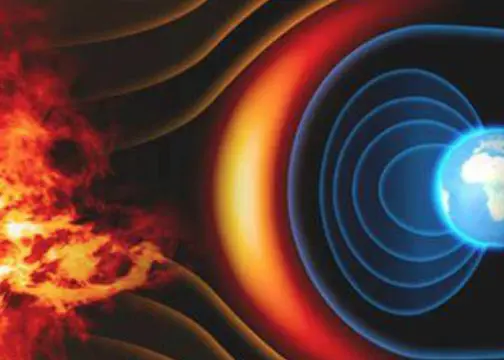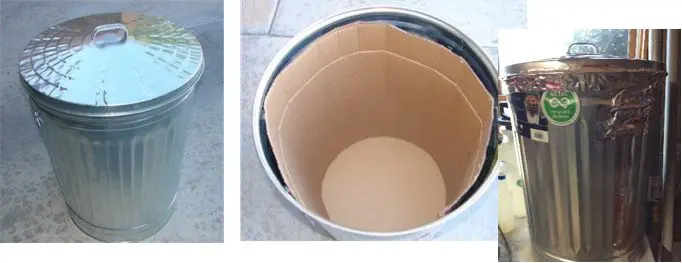An Electromagnetic Pulse, or EMP, can be produced in our atmosphere either from a high-altitude nuclear device or from the Sun. When the pulse comes from the Sun, it is called a Coronal Mass Ejection or CME. An EMP from either source can destroy or partially disable our electric grid as well as our personal communication devices such as computers, VHF and HF radios, televisions, and appliances.
A good description of the EMP mechanism from a nuclear weapon or device is stated in paper from the Washington State Division of Environmental Health and Office of Radiation Protection:
The most important mechanism for Electromagnetic Pulse (EMP) production from a nuclear detonation is the ionization of air molecules by gamma rays generated from the explosion. These gamma rays ionize the air molecules by interacting with the air molecules to produce positive ions and recoil electrons called Compton electrons.
This pulse of energy, which produces a powerful electromagnetic field, particularly within the vicinity of the weapon burst, is called an electromagnetic pulse. EMP can also be produced from non-nuclear sources, such as electromagnetic bombs, or E-bombs. High-altitude nuclear detonations and electromagnetic bombs can generate EMP that has the potential to damage or destroy electronic devices over widespread areas. Electric power systems would also be at risk from surges produced by such weapons. However, the EMP from a kiloton-range surface nuclear explosion would not be expected to produce serious damage outside the radius of severe destruction from blast.
A 1.4 Megaton bomb launched about 250 miles above Kansas would destroy most of the electronics that were not protected in the entire Continental United States. During the brief return to atmospheric testing in 1962, a 1.4 megaton nuclear weapon was detonated over Johnston Island at an altitude of about 250 miles. The effects of EMP were observed in Hawaii, 800 miles east of the detonation. Streetlights and fuses failed on Oahu and telephone service was disrupted on the Island of Kauai.

An electromagnetic pulse is a burst of electromagnetic energy produced by a nuclear explosion in the atmosphere, considered capable of widespread damage to power lines, telecommunications, and electronic equipment. [Fm: US Department of Homeland Security].

From: Anne, Arundel City, MD
Solar EMP
When the Sun puts out a Coronal Mass Ejection (CME) from a geomagnetic solar storm, the atmosphere becomes highly charged which can induce severe currents in power lines, satellites, computers, radios and other electronic devices.
In a solar storm called the Carrington Event of 1859, a huge Coronal Mass Ejection caused untold damage to the telegraph systems in the US, causing fires and destroying entire relay telegraph stations.
Another example of a solar CME occurred in 1989, when a CME produced a blackout across the entire province of Quebec in Canada.

On July 8, 1962, the EMP from the high altitude (250 miles above Johnston Island) “Starfish Prime” [Fm Atomic Archives.com]

A geomagnetic disturbance is a temporary disturbance of the Earth’s magnetosphere caused by a solar wind shock wave and/or cloud of magnetic field that interacts with the Earth’s magnetic field. [Fm US Department of Homeland Security] Fact Sheet >
Fast Forward to Today
Most modern-day electronics have very small internal runs of thread-like circuits with multiple microchips, which are vulnerable to the high current caused by an EMP from either a HEMP (High Altitude EMP) from a nuclear device or a solar CME.
EMP Affected Systems
Many of our enemies have noticed our lack of action in hardening our electric grid and other critical systems to a HEMP. North Korea, China, Iran, and Russia all have the capability to launch a high-altitude nuclear attack. Such an attack would not harm those on the ground, but would certainly inflict major damage to our electrical grid.
A HEMP would induce extreme currents in power lines, which will act as a sort of antenna to cause explosions in transformers and melting of relay station equipment.
A solar CME event might be similar but could also occur on a more regional level.
Why Communication is Absolutely Essential, even as it is related to our power grid (from The Report from the Commission to Assess the Threat to the United States from Electro Magnetic Pulse):
Loss of telecommunications would not, by itself, cause immediate system collapse except as needed to address issues caused by the above disruptions. However, the lack of telemetered control data would make the system operators effectively blind to what is going on, but personnel at substations, if they can get there and communicate with the system operators, could overcome much of that. Malfunction of protective relays could cause system collapse by contributing to several of the above scenarios through misinformation or by operating incorrectly.
Importance of our CORAC Mission
Our mission as CORAC members is of course to be prepared to help in charitable ways when there is a national or regional emergency.
Since communications is a critical element of being able to access and respond to any local or national emergency, it is imperative that we protect our various electronic devices in order to remain in contact with our members and the general public. In short, if we cannot communicate with each other, we will be of little help.
Levels of Protection for our Devices
In The Report from the Commission to Assess the Threat to the United States from Electro Magnetic Pulse, four (4) different levels of protection are indicated for equipment and the electrical grid. Classified as levels one (1) through four (4), going from simple techniques to military-level hardening measures, our interest lies in the first two levels due to simplicity of achievement and relatively low cost.
In simulated EMP testing, varying results were obtained when exposing different pieces of electronic gear including computers and HF, VHF, and UHF radios to a simulated EMP environment. Some smaller devices including radios did well, while computers failed or sometimes lost only some USB port locations. Any long wire or antenna connected to radios greatly exacerbated the damage to that equipment.
To increase our communications resilience on behalf of our CORAC sections, here are the first two ways to help mitigate an EMP or CME event (taken from the National Coordinating Center for Communications Manual of Electromagnetic Pulse (EMP) Protection and Resilience Guidelines for Critical Infrastructure and Equipment).
Level 1
- Unplug power and data lines from spare or backup equipment where feasible. Best practice for lightning and energy savings and there is no extra cost to leave a cable unplugged. $0
- Turn off equipment that cannot be unplugged and is not actively being used. Best practice for lightning and energy savings and there is typically no extra cost to turn off something. $0
- Use at least a lightning rated surge protection device (SPD) on power cords, antennas, and data cables; maintain spare SPDs. Best practice for lightning and energy savings as well as EMP; thus, assume these are already deployed or will be used if it’s a new installation.
- Power Supply SPD (e.g., $15 for 6 outlet APC Surge Arrest that will alert the operator when it’s no longer fully operational).
- SPDs with Gas Discharge Tubes (GDTs) that are not soldered are preferred for easy replacement. For example, the Alpha Delta TT3G50 lightning SPD costs around $50, its replacement cartridge costs under $15. $0
- Wrap spare electronics with aluminum foil or put in Faraday containers.
- Store spare electronics in an area with at least 20 dB protection. This is adequate for smaller electronic devices (or battery powered devices) as might be required for an HF site. $0
Level 2
- HF Transceiver & PA Power Supply SPD – To obtain an SPD (Surge Protective Device) for the power cable that protects against EMP, the SPD’s recovery time should be 10 ns or less. Note: The $200 Transtector 6 outlet AC Surge Protection device SLV Surge Cord has a published tested specification of 5 ns. It costs about $180 more than a lightning only SPD.
- Shielded RF Antenna Cable – No extra cost since low inductance and lightning protected cables can be selected that also provide EMP protection. For instance, RG-213 is double shielded/braided, or one can use low loss LMR-400, which is braided plus has a foil shield; (this is not as good as double shielded/braided).
- Antenna RF Cable SPD (Surge Protection Device) – The NexTek HF (1-50 MHz) SPD part FPNNMNFBCA3B, which has been tested per MIL-STD-188-125-1, costs approximately $200 (minimum order may apply). Note: This is $150 more than the Level 1 SPD listed (plus the replacement cost is considerably higher). $200
- Antenna Cable Ferrites – Can buy a package of these for under $10. $10
- Antenna Tuner SPD – Use extra SPD outlet purchased above or can connect into the UPS for surge protection.
- Computer Power Cable SPD – Connect to UPS for surge protection. $0
- Fiber Optic Media Converter SPD – Connect to UPS for surge protection.
Now here are my suggestions for protecting spare receivers, cables, spare batteries, computers and other devices susceptible to EMP:
Use a Faraday Cage – What is a Faraday Cage?
- A Faraday cage is named after Michael Faraday, the scientist who discovered its properties The Faraday for shielding against electromagnetic waves, including electricity. You can build simple Faraday cages at home at a very low cost that will work just as well as the expensive ones that the government uses. All it takes is some common household items.
How does a Faraday cage work?
- A Faraday cage protects its contents by preventing electromagnetic energy from getting inside. You can build your own at home using aluminum foil and a galvanized steel trash can.
- By the way, Faraday shielding doesn’t actually have to be a “cage.” It’s simply any container that blocks electromagnetic radiation.
- Many places on the Internet claim that a microwave oven or Mylar bag protects devices from EMP. Mylar bags do not seem to provide good protection. The microwave oven as a Faraday container isn’t something you can rely on as it generally protects only microwave frequencies (hence microwave oven).
- The frequencies for EMP range from approximately AM radio to approximately FM radio. The important thing to know is that you can test how effectively a container shields electromagnetic frequencies by using an AM/FM radio or an HT or Walkie Talkie.
Testing the Faraday container
- It’s a simple process to determine if a container will function as EMP shielding.
- First, use a Handy Talkie [handheld ham, FRS, GMRS, MURS, etc. radio] or Walkie Talkie and turn up the volume. Put it into the Faraday cage you’re testing, along with a second cell phone and transmit the HT and listen to see if the other radio is still being picked up via the cell phone to an outside phone.
- Anything that can block your HT or Walkie Talkie signals should be a good Faraday cage.
Making the Faraday cage
A good Faraday cage can be an ammunition box or even a galvanized aluminum trash can. When using one of these, line the ammo can or trash can with cardboard (to insulate stored devices from the metal exposed to the EMP) and then wrap each item to be stored with aluminum foil (at least two layers thick). This thick aluminum foil itself is a good shield against RF radiation.
Items to protect include radios, receivers, small batteries, coaxial cable, laptops, etc. Remember to store an extra one or two antennas. Coax is susceptible to melting foam dielectric with ultra-high currents from EMP’s.

Metal Tape- Get metal tape at your nearest hardware center and be sure to seal all openings on the lid, handle, side seam and bottom seam.
I have put away many items in both these trash cans and ammunition cans.
For all of my coax (antenna line) runs, I use gas discharge type lightning arrestors before the coax enters my shack (the radio room). For window or ladder type antenna line, I also use surge protectors, although these are not as good as gas discharge units for coax, so I also use EMP Shield [a name brand suppressor] to back up the window line arrestors. EMP Shield >
When not in use, unplug your radios from the antenna lines and electrical power, or at least have a Surge Protecting Device in each of those lines (antenna and power) connected to the radio.
Here is a picture of a coax run outside of the shack with lightning arrestors attached to ground rods.

In Summary
From the above sources, Levels 1 and 2 make the most sense for our CORAC team. Most cannot afford two sets of radios and this leaves some good basic measures listed in those levels:
When not on the air, disconnect your electrical and coaxial cables. It is highly recommended that each operator purchase a good surge protector device (SPD).

This is a picture of one of my Trip-Lite brand Surge Protecting Devices.
When bringing in coaxial cable to the shack, use a ground rod (it is best to do a triangular 3 ground rod system connected with copper strap or ribbon) with a well-rated lightning arrestor from the closest ground rod.
When using ladder or window line, use a ground rod with a window line lightning arrestor, e.g.: Surge and RF Protection >

























0 Comments